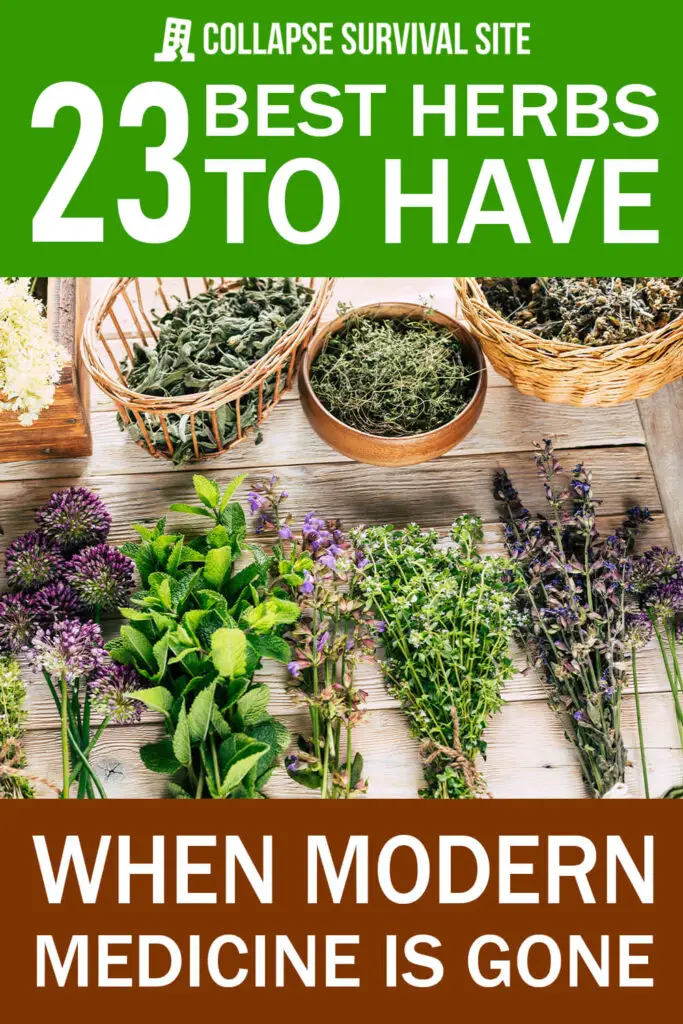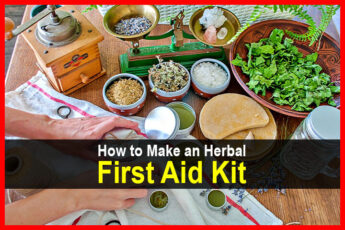Estimated reading time: 8 minutes
As someone seeking to live a more sustainable lifestyle, you already know the benefits of growing your own food. But have you also considered growing plants for medicinal purposes?
For thousands of years, people have been growing medicinal herbs to treat disease and to maintain physical and mental health. In modern times, many prescription and over-the-counter remedies are derived from botanical sources.
One of the primary advantages of growing your own medicinal herbs is that you can ensure they are free from pesticides and other chemicals. Another is the cost savings of simply clipping what you need for an herbal treatment rather than purchasing a product at the store.
Still, another benefit is the peace of mind you can have knowing that you can treat many common injuries and ailments at home in the event supply chains falter or pharmacies close during a crisis. This article offers an alphabetical list of some of the best herbs to grow for medicinal purposes and how you can use them.
1. Bee Balm
Bee balm (Bergamot or Monarda) has anti-viral, anti-bacterial, and anti-fungal fungal properties. Native Americans used it to treat fevers, congestion, coughs, infections, sore throat, and insect and snake bites.
It also soothes the stomach and can ease stomach cramps. Here's more on growing bee balm in your garden.
2. Calendula
You can make a healing oil or tea with calendula (also called pot marigold), which features beautiful flowers that attract pollinators.
You can treat minor burns and skin irritations, including diaper rash, and superficial wounds with this anti-fungal herb. Here's information on growing calendula.
3. Chamomile
Chamomile is often used in tea for its relaxing and sleep-inducing properties. You also can use this herb to help heal wounds and reduce swelling and inflammation.
You can also use chamomile to treat stomach upset, gas pain, and conjunctivitis and to help reduce a fever. This medicinal herb is easy to grow – here are some tips.
4. Dill
You may only think of dill for its distinctive flavor in foods such as deviled eggs and, well, dill pickles, but you can also use it for healing purposes.
You can use dill to help treat upset stomach, bloating, and menstrual cramps. This medicinal herb is an excellent source of vitamins A and C, calcium, and iron. Here is a guide for growing dill
5. Echinacea
Echinacea has been used for many centuries to treat cold and flu symptoms. It also may help boost the immune system and aid in wound healing.
The echinacea plant features bold flowers that attract pollinators and provide a lovely addition to your garden. Here is how to grow echinacea.
6. Feverfew
As its name implies, feverfew is used to treat fevers, but it also helps ease headaches, migraines, arthritis pain, mouth ulcers, and digestive issues. Here is how to grow feverfew, which is part of the daisy family.
7. Garlic
You know that garlic adds flavor and nutrition to many of your favorite recipes. But you also can use it for medicinal purposes.
Garlic has antibiotic, anti-fungal, and anti-viral properties and can be used to treat colds and flu symptoms, skin infections, and tooth abscesses. It also has bene linked with lower blood pressure and cholesterol levels.
8. Ginger
Ginger has a well-deserved reputation for helping ease motion sickness and nausea, including nausea related to pregnancy or chemotherapy treatments.
Ginger has anti-inflammatory and antioxidant properties. Here is what you need to know to start growing ginger.
9. Ginkgo
Herbalists use extract from ginkgo leaves to treat fatigue, asthma, bronchitis, and tinnitus.
Some studies also link the use of gingko (ginkgo biloba), which has a long history in ancient Chinese medicine, with improved memory. Here's more on this ancient medicinal plant.
10. Ginseng
The medicinal benefits of using ginseng include increasing energy, lowering cholesterol and blood sugar levels, and reducing stress. It also may help fight inflammation and swelling.
Here is a beginner's guide to growing and harvesting ginseng, long a part of Ancient Chinese and other Asian medicinal treatments.
11. Goldenseal
Goldenseal is often used to help ease eye and skin irritation, diarrhea, canker sores, urinary tract infections, and vaginitis. Here is information on how to grow goldenseal in your home garden.
12. Hollyhocks
If you're looking for a home-grown sore throat remedy, you might want to consider hollyhocks. As a mucilaginous herb, hollyhocks also help treat stomach upset, rashes, and other skin irritations.
Take a look at this article for tips for growing hollyhocks, and here's more on the medicinal benefits of these flowers.
13. Horseradish
Known for the spicy kick it gives as a dip for meat dishes, horseradish also can be used for medicinal purposes. For example, herbalists use this plant's root to treat sinus, bronchial infections, and urinary tract infections. This article describes how to grow horseradish in your home garden.
14. Lavender
This perennial herb is as helpful as it is lovely to look at and smell. Lavender, which can be used as is or in an extract or tea, has anti-inflammatory and antioxidant properties. Here are some of the many medicinal benefits of lavender:
- Promote sleep
- Boost mood
- Relieve menstrual pain
- Reduce colic
- Kill some viruses and bacteria
- Aid in wound healing
15. Lemon Balm
A member of the mint family, lemon balm is a helpful addition to your garden, especially as it is gentle enough for children. This article offers tips on growing lemon balm at home.
Here are some of the benefits of lemon balm as a medicinal herb:
- Reduces fever
- Calms cough
- Relieves congestion
- Calms nerves
- Promotes sleep
- Eases stomach upset
16. Milk thistle
Herbalists have used milk thistle to help treat liver and gall bladder problems and lower high cholesterol. It also is used to treat viral hepatitis. Watch this video for information on growing and harvesting milk thistle in your home garden.
17. Oregano
This flavorful and nutritious herb is a perfect addition to many Italian recipes, but it also has the added benefit of having anti-viral, anti-fungal, and antioxidant properties.
You can grow oregano indoors on a sunny windowsill or outdoors in a container or garden bed. Here is a guide for growing and harvesting oregano.
18. Peppermint
Peppermint can help treat all kinds of stomach upsets, including motion sickness. It also can help soothe frayed nerves and headaches and open congested sinus passages.
Like other members of the mint family, peppermint can take over your garden if you're not careful. You can solve this problem by planting it in a container.
19. Sage
Sage leaves add flavor to many recipes and can also offer many health benefits. Simply chewing fresh sage leaves can help ease pain from a toothache, sore throat, or mouth sore. Here are tips for growing sage in your home garden.
20. St. John's wort
St. John's wort, which boasts yellow star-shaped flowers, may help regulate mild mood disorders as well as some of the symptoms of menopause. This cheery plant works well as an attractive and easy-to-care-for ground cover in the home garden.
21. Tulsi
Also known as holy basil, tulsi can help reduce stress and improve mental focus. The plant may also help lower blood sugar and “bad cholesterol” and decrease inflammation in the body.
Watch this video for tips on growing and harvesting this helpful herb.
22. Valerian
The root from the valerian plant may help reduce stress and anxiety and allow you to sleep better. Here is how to grow this hardy, perennial plant.
23. Yarrow
Yarrow can be used to treat a host of health and medical issues, including fever, common cold symptoms, diarrhea, minor wounds, hay fever, stomach upset, and toothache. Here is a guide for growing this bright yellow flowering medicinal plant.
How to Use Herbs Safely for Medicinal Purposes
Before you start using your home-grown herbs – or any herbs – as medicine, it is important to educate yourself.
For example, some herbs may negatively interact with other medicines you are taking or be harmful when taken in high doses or when other conditions are present.
Talk with your healthcare provider about any risks or side effects that are particular to your family. Also, let any healthcare provider know that you are using herbal medicines when you seek other treatments.
When determining what medicinal herbs to grow, consider the health needs of your family and the garden space you have. Check seed packets for light, water, and soil requirements. Some herbs are perennials, meaning they'll come back year after year, while others are annuals.
You'll also want to think about the part of the plant you need to make any medicine. For some plants, you need only to snip the leaves. However, with others, you must harvest the root. You'll want to be aware of the location of these plants so that you do not disturb other plants growing nearby.
Here are some additional resources to help you plan your medicinal herb garden.
- Medicinal Herbs: A Beginner's Guide by Rosemary Gladstar
- The Medicinal Garden by Anne McIntyre
- Grow Your Own Medicine by Ava Green and Kate Bensinger
- The Beginner's Guide to Medicinal Plants by Amber Robinson, PhD
- Forget The Pharmacy by Jenni Rempel
- The Herbal Medicine-Maker's Handbook by James Green








